Corsair Obsidian 500D Review
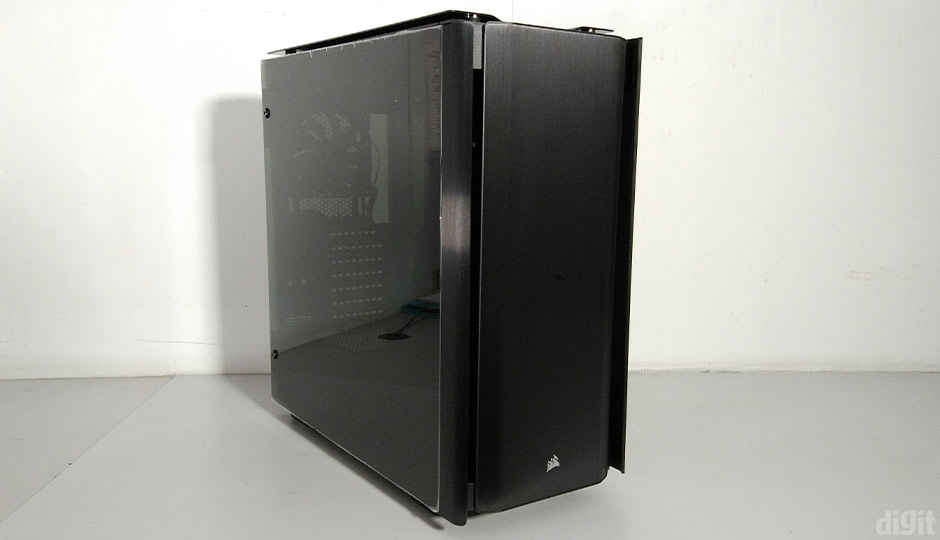
- 13599/-
Corsair Obsidian 500D Price in India
Corsair Obsidian 500D Rating 71100100
Our Verdict
The Corsair Obsidian 500D brings the basic features you would expect in a premium case. It continues the legacy of the Obsidian series to support high-end cooling solutions. Of course, it could have done better. In 2018, it’s expected now for cases to include a fan and lighting hub out of the box. If you run out of cooling fan or RGB headers on your motherboard, you won’t be able to use the case to its full potential. This is something we would want high-end cabinets like the Obsidian series to include. The tempered glass hinged side window doors on both the sides offer the premium feel to the cabinet. They are removable and have a smoked tint to them. We are happy that the front I/O ports include a USB 3.1 Type-C port. However, we would have appreciated if the cabinet included fan speed controllers and PWM fans shipped inside.
Cooling performance was impressive in both our stock and full fan capacity stress tests. The cabinet clearly performs significantly better with more intake and exhaust fans. At this premium price, we expected more fans to be included other than the two. However, enthusiasts are more likely to go for aftermarket fans anyway. For its price, the Obsidian 500D does seem expensive and the lack of one or two premium features is a complete miss by Corsair. Overall, it’s a great cabinet for enthusiasts looking for a premium finish.
PROS
- USB 3.1 Type-C port on the front I/O panel
- Tempered glass side window doors are hinged
- Great build quality
CONS
- Only two fans included
- No lighting and fan hub
- Expensive
Corsair Obsidian 500D: Detailed Review
After several years, Corsair revealed a new cabinet in the Obsidian series of enthusiast cabinets. Two variants of the Obsidian 500D were first announced at CES 2018. The first variant had hinged-tempered glass side panels on both the sides with an aluminium front panel. The other variant, called the special edition, had the same tempered glass side panels along with a curved tempered glass panel on the front. We received the first variant for testing. The front panel has a beautiful brushed aluminium finish similar to the one seen on their mechanical keyboards. This same finish is carried on the edges of the side glass panels and the top panel. The hinged panels are removable and the glass has a smoked tint. With the help of fan and radiator mounts on the top and front panel, the installation process is easier. You will find dust filters on the top, front and bottom of the cabinet. The front and top panel dust filters attach using magnets. The final highlighted feature of the cabinet is the USB 3.1 Gen-2 Type-C port on the front I/O panel. It’s the first time that Corsair has incorporated this port in their cabinets.
Packaging and accessories
Opening the box, we find the Obsidian 500D inside a bag and enclosed inside regular styrofoam. Since the Obsidian belongs to a premium segment, we expected the packaging to be more robust. The packaging and quality of styrofoam on Cooler Master’s higher-end MasterCase series is a good example.
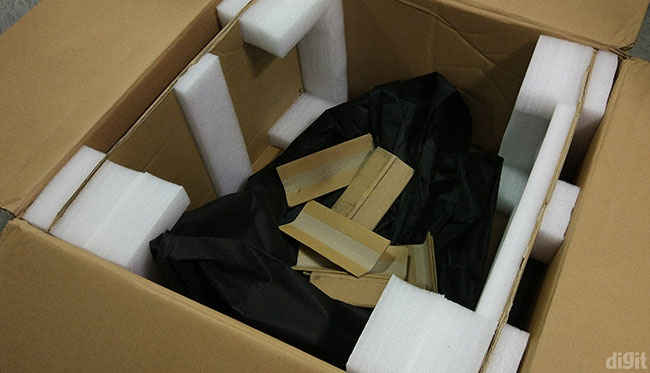
The accessories include the regular screws for the motherboard standoffs, PSU, storage drives, radiators, fans, etc. You also get a few cable zip-ties and two velcro straps for cable management. There are a few vibration dampeners and screws for the HDD drive bays as well.
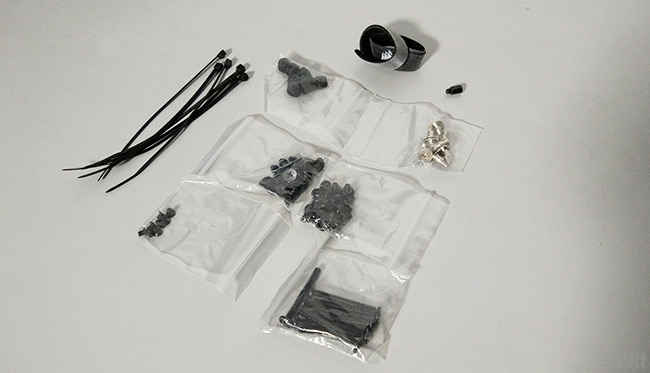
Technical specifications
Motherboard form factor: Mini-ITX, Micro-ATX, ATX
Power supply standard: ATX standard (max. length of 225mm)
I/O ports: 2x USB 3.0, 2x USB 3.1 Gen-2 Type-C, 1x microphone, 1x headphone
Drive bays: 2 x 3.5-inch HDD, 3 x 2.5-inch SSD
Cooling support: 3 x 120mm (front), 2 x 140mm (front), 2 x 120mm (top), 2 x 140mm (top), 1 x 120mm (rear)
Radiator support: Up to 280/360mm (front), up to 240/280mm (top), up to 120mm (rear)
Clearances: CPU cooler - 170mm, Graphics card - 370mm
Dimensions (H x W x D): 508mm x 233mm x 502mm
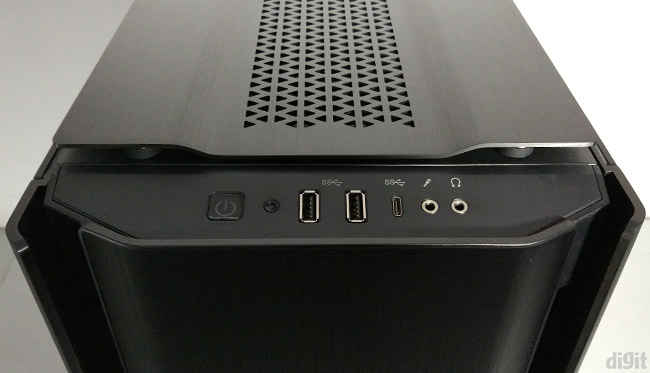
Exteriors of the Corsair Obsidian 500D
We reviewed the regular variant of the Obsidian 500D with the aluminium front panel. It has a brushed aluminium finish with the Corsair logo at the bottom. The front panel has a gap of about 3 cm for air intake. A magnetic dust filter is installed behind the panel. Due to the curved design of the side doors, they almost cover up the gap. This further reduces the room left for air intake from the front panel. The front panel is non-removable. Otherwise, it would have been interesting to test how well the case could perform with an open front panel.
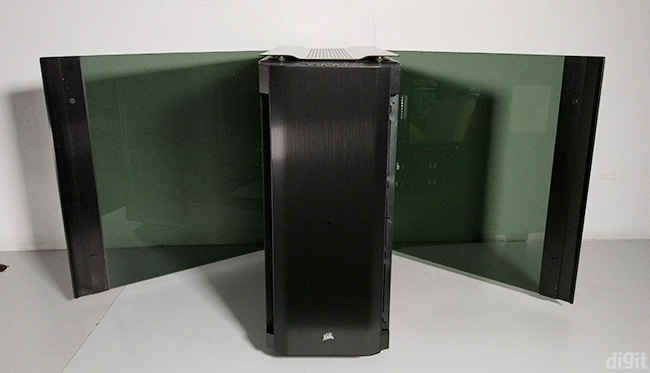
There are tempered glass side panels on both the sides. They have a thickness of 4mm and there’s a black tint throughout. This will help dim the bright lights emitting from your components. A hinged-mechanism is used to open the side doors. The glass panels have an aluminium strip on the edge that closes towards the front panel. The aluminium strips bend towards the frame maintaining a sleek design. Two magnets are attached on these strips that stick to the steel frame of the chassis. This is the same for both the panels. In our review unit, one of the panels didn’t attach properly to the frame. Only the bottom magnet stuck while the top magnet couldn’t reach the frame. Although there wasn’t any visible damage after delivery, we are hoping that this was an exception to our unit.
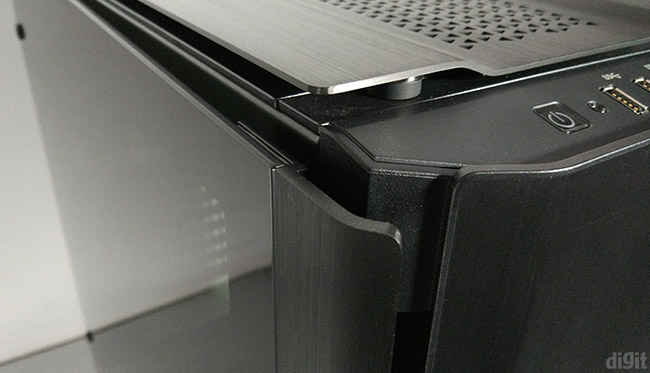
The hinged panels can be removed after taking out the single screw on the top hinge. Usage of hinged side panels is always appreciated, although it’s only seen in premium cabinets. It gives you easy access to the components inside.
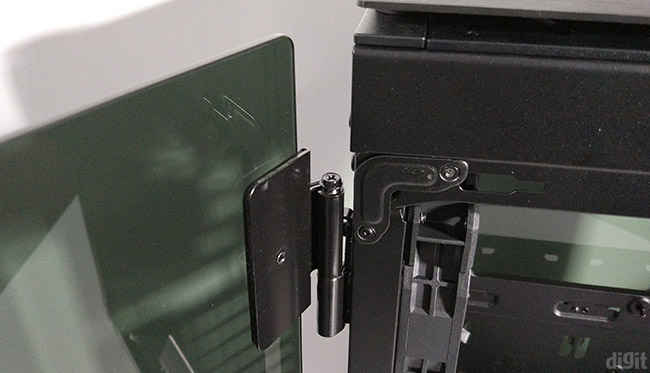
The top panel is also non-removable. The design of the panel looks more like the wings of an aircraft. It follows the same brushed aluminium finish aesthetic found on the front panel. There’s a magnetic dust filter below that can be easily pushed out.
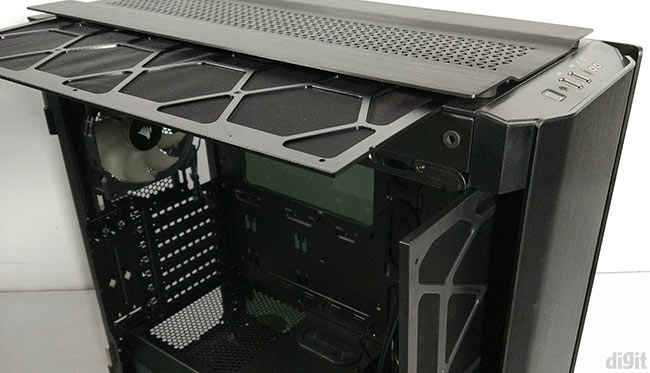
On the rear, you will find seven expansion slots for PCI-e cards. There are two additional expansion slots for components installed vertically. This is a great addition to enthusiast builds where users can display their graphics cards better. The package doesn’t include a riser cable or stand and needs to be bought separately. All the expansion slots are tool-free, although you might need a screwdriver for the first time on the thumbscrews.
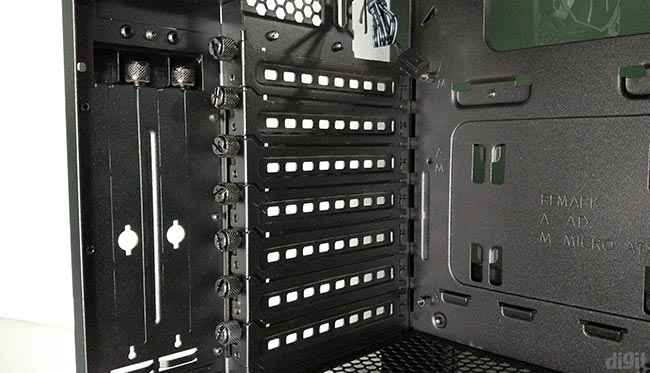
There’s nothing fancy happening in the bottom panel. A removable dust filter can be found right below the PSU.
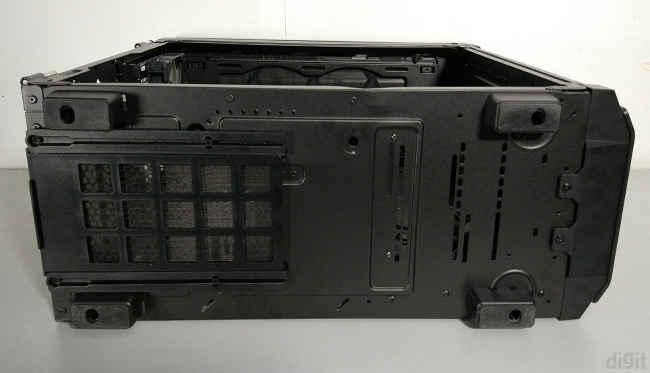
Inside of the Corsair Obsidian 500D
Swinging open the cabinet reveals the clean and neat interiors. Behind the front panel, a 120mm fan is already installed. The fan is installed on a fan mount that can house all the supporting fans and radiators. This mount is removable so you don’t have to struggle while installing the fans. Radiator installation becomes easier too. It can be painful sometimes to screw in the top screws when you’re installing the radiator on the front panel.
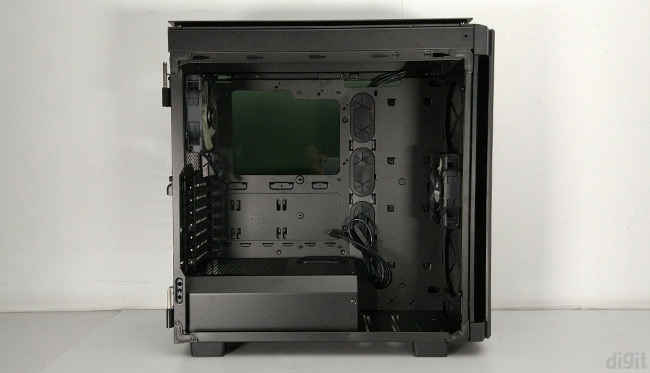
In this age, cabinets have totally dropped support for 5.25-inch optical drives. All the older cabinets in the Obsidian series included several optical drives. The Obsidian 500D becomes the first one in the series to move on with modern times and not include them. You won’t even find a 3.5-inch HDD cage as well. Support for HDDs has been moved to the back. More on them later. With the optical and hard drive cages out of the way, there’s only one thing you would do in an enthusiast cabinet. And that’s installing pumps and reservoirs for water cooling. Mounting holes are present at the bottom to install your liquid reservoirs.
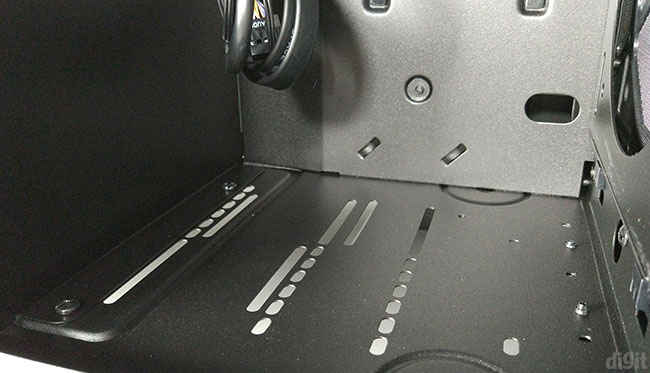
The PSU shroud can accommodate your power supply and the extra cables dangling behind the motherboard plate. On top of the shroud, a rubber grommeted cutout is present to route cables. For a cleaner look, you can route the front I/O cables through this cutout to the motherboard. The shroud is removable but not tool-free.
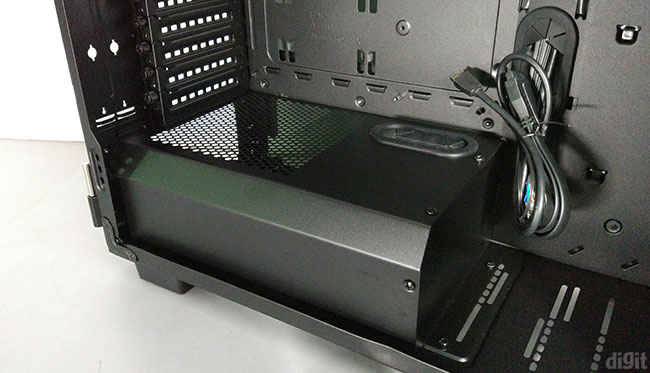
Cable management shouldn’t be a problem with a modular or semi-modular PSU. There are enough cutouts on the motherboard plate to route cables from all the components. A cable shield on the back of the motherboard not only holds but also hides away the cables. Especially, the thick 24-pin motherboard power cable. This shield is attached to the plate using thumbscrews. It’s always fun and satisfying to assemble a build in a cabinet with provisions for better cable management. However, we would have appreciated if cable routes were also added instead of just cable tie points behind the plate. That would have potentially made the build look cleaner. This doesn't mean that you can't achieve a clean build with the existing provisions.
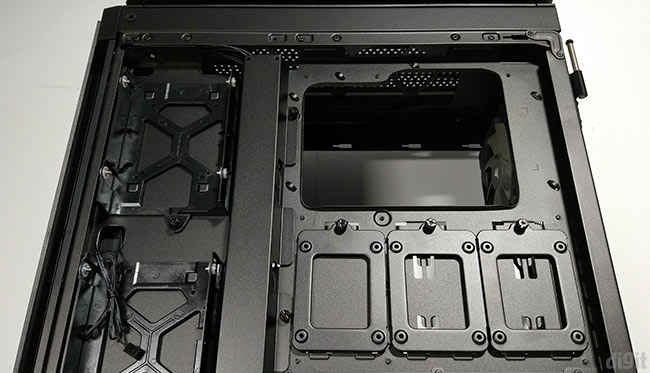
Behind the motherboard plate, right below the CPU cutaway, there are three suspended trays for 2.5-inch SSDs. Towards the front panel, you will find two suspended trays for 3.5-inch HDDs that also support SSDs. Installing HDDs are completely tool-free. The only concern we had with them was their orientation. If you’re one of those who want to display the brand of your HDD, you won’t be able to in this cabinet. The brand sticker comes on the inside after installing the HDD. Although, the SSD trays will ensure that the brand sticker side is visible.
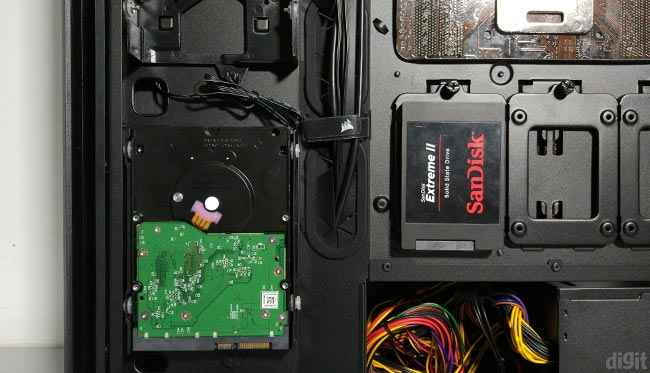
There’s a lot of room below the top panel to accommodate fans and radiators. With a clearance of around 5-6cm, you will be able to install thick radiators on the top. If the rear fan hinders the clearance, it can be moved down. A fan mount similar to the one behind the front panel is present here as well.
Testing methodology
We recently upgraded our testing methodology for full ATX cabinets. The testbed remains the same. Changes were made to the duration of the benchmarks. More emphasis has been put on consistent peak temperatures rather than the peak temperature after a particular time. Earlier, we tested the cabinets only in the factory shipped state, i.e., with the included fans. The upgraded parameters test the cabinet to its full potential of air cooling by populating all the fan slots. Our testing configuration is as follows:
CPU: Intel Core i7-4960X
Motherboard: ASRock X79 Extreme9
Graphics card: Sapphire Radeon HD 7790
CPU Cooler: Noctua NH-L9x65
RAM: Corsair Dominator 2x8GB DDR3 (16GB)
HDD: WD Red 2TB
SSD: SanDisk Extreme II (240GB)
Power supply: Antec HCP-1000 Platinum
All the stress tests ensure that maximum amount of heat is generated. The primary components were chosen since they tend to generate a lot of heat. The CPU is run at the stock speed which is 3.6 GHz. We didn’t overclock the CPU since the temperatures were high enough. The GPU is overclocked to 1.1 GHz with the fan speed set to 100% during stress tests only and not while idling. Before beginning the stress tests, the test rig is left idle for 15 minutes. The ambient room temperature is recorded every time and adjusted to a standard temperature of 25 degrees Celsius. We’re also measuring the temperature near the CPU fan, GPU exhaust, and the rear panel exhaust fan with a thermocouple. CPU stress testing is done with Prime95’s In-place large FFTs running for 15 minutes on 12 threads. FurMark’s GPU stress test is also run for 15 minutes. To put the HDD and SSD into stress, we move the Steam backup of DOOM, which is around 56GB, to and fro between the two storage drives. The rise in temperature in both of them is recorded. After the stress tests are stopped, the drop in temperature at specific time intervals is also recorded for the CPU and GPU. Once done, the stress testing is repeated after all the fan mounts have been populated with fans.
Thermal performance
The Corsair Obsidian 500D is the first cabinet that went through our updated testing methodology. The first set of stress tests were performed on the stock fan setting. This included the two 120mm fans on the front and rear. After leaving the system idle for 15 minutes, the CPU stabilised at 41 degrees Celsius and the graphics card cooled down to 37 degrees. The In-place large FFTs test in Prime95 tries to generate maximum heat from the CPU. It was able to push the temperature upwards and stay consistent at 59 degrees after 15 minutes. On Furmark, we run the GPU stress test for 15 minutes. From 37 degrees, the graphics card’s temperature rose and stabilised at 70 degrees. When the temperatures stabilise during the stress test, we measure the time required by the cabinet to reach their previously recorded idle temperatures. The CPU took about 13 minutes while the graphics card dropped to the idle temperature in four minutes. To standardise the drop in temperature, we take readings at a specific time after the stress test has stopped. For the CPU, it’s at the five-minute mark while for the graphics card, it’s after a minute. The temperatures came out to be 43 degrees for the CPU and 44 degrees for the graphics card.
In order to test the full potential of the cabinet, we installed fans on the remaining slots. The same set of tests were repeated. This time the CPU reached 52 degrees and the graphics card went up to 60 degrees. The cabinet clearly performs significantly better with more intake and exhaust fans. Cooling performance on the Obsidian 500D is impressive. However, we feel that the limited gap for air intake might be holding it back. At this premium price, Corsair should have made the front panel removable. This would have given us the liberty to choose whether we want superior looks or better cooling performance.
Other Popular Deals
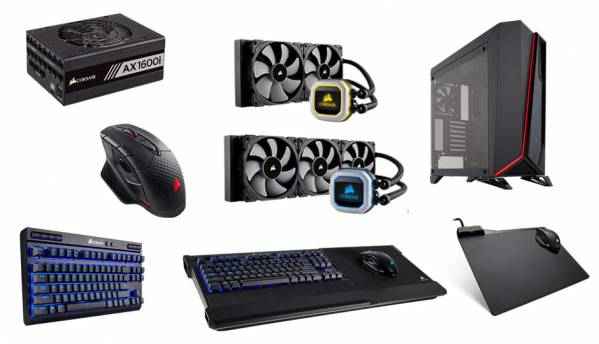 Everything announced by Corsair at CES 2018
Everything announced by Corsair at CES 2018Corsair announced a range of new products and innovations at CES 2018. PC builders will be in for a delight with the new Corsair AX1600i PSU for...
10 - Jan - 2018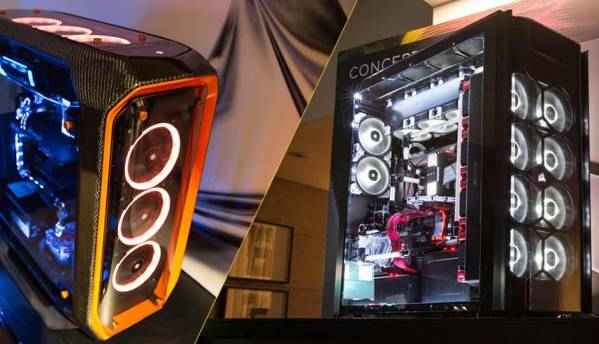 Corsair at Computex 2017: Concept Curve, Concept Slate, SYNC IT and new liquid cooling options
Corsair at Computex 2017: Concept Curve, Concept Slate, SYNC IT and new liquid cooling optionsCorsair today revealed two concept PC systems and a range of innovative new technologies, strongly indicating the direction that the next...
30 - May - 2017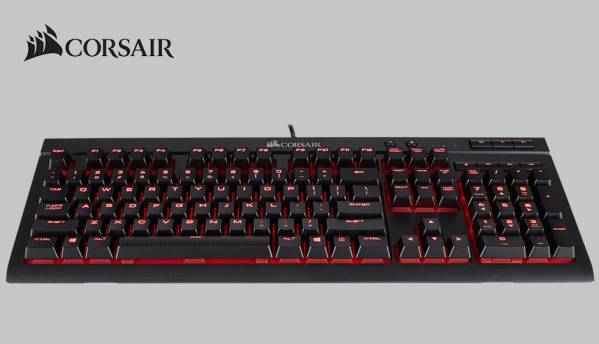 Dust and spill resistant Corsair K68 Gaming Keyboard launched at Computex 2017
Dust and spill resistant Corsair K68 Gaming Keyboard launched at Computex 2017Corsair, among other announcements, today also announced the new CORSAIR K68 mechanical gaming keyboard. The K68 uses 100% CHERRY MX LED-lit...
30 - May - 2017

After several years, Corsair revealed a new cabinet in the Obsidian series of enthusiast cabinets. Two variants of the Obsidian 500D were first announced at CES 2018. The first variant had hinged-temp...
---------------------------------------------------------------------------
Visit this link to stop these emails: http://zpr.io/PnAEp






